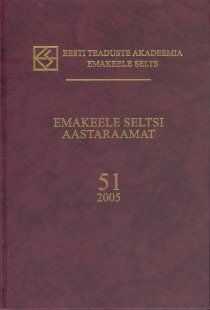Ööd tähistavad ajaväljendid eesti murretes, ühis- ja kirjakeeles
Time Expressions Denoting Night in Estonian dialects, Common Estonian, and Standard Estonian
Author(s): Eva VelskerSubject(s): Language and Literature Studies
Published by: Teaduste Akadeemia Kirjastus
Keywords: morphosyntax; parts of speech; dialectology; lexicalization; Estonian
Summary/Abstract: The article deals with the adverbialization of nouns and some borderline cases of word categories on the basis of specific time expressions. The article discusses öö- ‘night’ and ööse-stemmed forms in Estonian dialects; the analysed material comes from the electronic corpus of Estonian dialects. The author then studies the developments that have taken place in contemporary Estonian. The article discusses the use of ööse-form in Common Estonian (the term ‘Common Estonian’ stands for a variety of Estonian the norms of which are more liberal than those of Standard Estonian and which is used for everyday communication). In addition, the article discusses briefly the standard use and how suitable and standard the language users consider the öö- and ööse-forms. The developments that have taken place in the Estonian dialects are somewhat different from this in Common Estonian and Standard Estonian. In contemporary Common Estonian ööse stands between the noun and the adverb: its case paradigm is wider than that of the usual defective adverbs; it can take an agreeing attribute, even the partitive is used, and it is possible to form the plural (although this possibility is rarerly used). These properties relate it to the noun. However, the nominative is absent, and the form is used adverbially only. The standard language (language variety with stricter norms) reveals fewer possibilities for noun-like use; the adverbs öösel and ööseks, though, may take an agreeing adverb. The dialects also show signs of noun-like uses bus less so than in contemporary Common Estonian. The preferred forms include ööse- and öösi- without endings that could be treated holistically, whereas the adessive form öösel prevails in the standard language (and in the common language based on the latter), which is easy to break into parts, can be interpreted as a case form and allows the formation of other case forms by analogy. Also, analogy with time words could have some influence. However, certain constraints cannot be overcome; it is doubtful whether the form ööse could be used referentially and as a nominative form. The sentence Ööse oli ilus ‘The night was beautiful’ would still be interpreted as a time adverbial. Thus, for the time being it will not develop into a noun.
Journal: Emakeele Seltsi aastaraamat
- Issue Year: 2005
- Issue No: 51
- Page Range: 184-207
- Page Count: 23
- Language: Estonian

